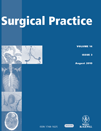Causes and treatment outcome of perforation peritonitis in north eastern Nigeria
Abstract
Background: Intestinal perforations cause generalized peritonitis and overwhelming sepsis resulting in high morbidity and mortality. The purpose of the present study was to review the causes and treatment outcome of non-traumatic perforation peritonitis in a government referral hospital in north-eastern Nigeria.
Patients and Methods: In a retrospective study, the clinical records of 153 patients with intraoperative diagnosis of non-traumatic perforation associated peritonitis managed in the Federal Medical Centre, Azare, Nigeria between June 2004 and May 2009 were reviewed.
Results: One hundred and fifty-three patients, comprising 112 males (73.2%) and 41 females were operated for perforation peritonitis, including 31 (20.3%) children. The mean age was 21.88 years ± 14.51 (range 4–70). The mean time lapse between onset of symptoms and presentation to hospital was 5.4 ± 3.7 days (range 0.75–21). Forty-eight (31.4%) of the patients were operated within 24 h of presentation and 105 (68.3%) after 24 h. The main symptoms were abdominal pain in 150 (98.9%), fever in 108 (70.6%), and abdominal distention in 108 (70.6%). The main causes of perforation peritonitis were typhoid ileal perforation in 98 (64.0%), perforated peptic ulcer in 25 (16.3%) and perforated appendix in 22. Tuberculous ileal perforation was seen in one (0.6%) patient. Wound infection 39 (25.5%) and wound dehiscence 15 (9.8%), were the most common postoperative complications. Enterocutaneous fistula was seen in 21 (13.7%) of the patients and was associated with mortality in nine (42.8%) patients. The overall mortality rate was 26.1%, mainly from overwhelming sepsis and severe electrolyte derangement.
Conclusion: The outcome of perforation peritonitis depended on the underlying cause, the duration of symptoms before treatment, and the general health of the patient. Typhoid ileal perforation is the most common cause of perforation peritonitis in our environment.




